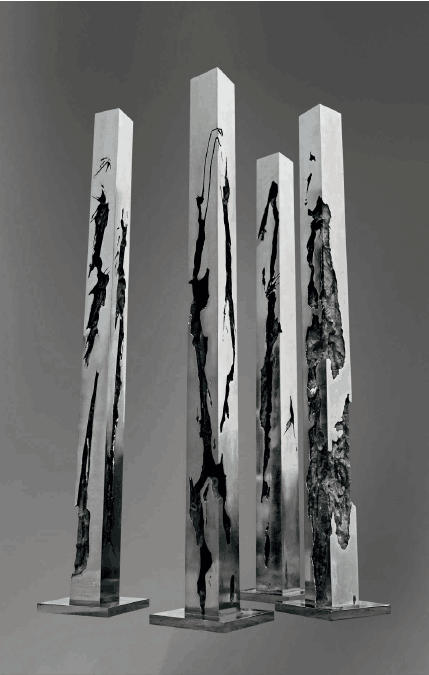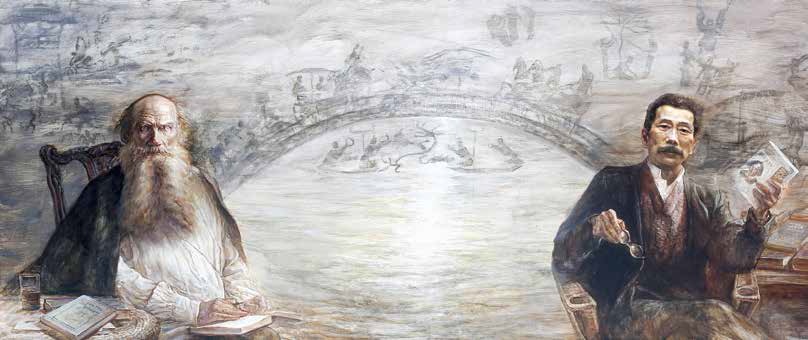
Feng Chongli(China)
Inkand Mud-Plum, Orchid, Bamboo and Chrysanthemum / 2011 /
sculpture / 20cm×20cm×126cm
Works of the 5thBeijing Biennale, 2012
The Beijing International Art Biennale has been established for 15 years. I have the honor to be a member of the curatorial committee, and, when traveling the world, I often get to feel its growing brand influence—almost all the dialogues with the peers, as long as China is concerned, cannot bypass the Beijing Biennale. I remember that when I was attending the events of two embassies in Europe, both of the countries’ art masters were introduced to inquire about the exhibition. Last year in the United States, a number of local Chinese media also expressed the willingness to introduce the Beijing Biennale. I have witnessed the increasingly evident image, popularity and reputation of the Beijing Biennale, which concentrated the cultural influence of China.
In this age of prosperity, the Beijing International Art Biennale has left at least six distinct imprints in the history of art.
First, the imprint on the nation. With the deepening of China’s reform and opening up, the rising of the nation and her cultural renaissance, China’s influence is becoming deeper and broader. The Beijing Biennale fully conforms to the trend of the times and moves forward with the prosperity of the country. The different themes have confirmed its relevance and closeness to the will of the state. It has become a gear complying with the general operation of the nation, which is both driven by and adding to the country’s prosperity. It has deepened the latest growth rings of this five thousand years old Oriental country.
Second, the imprint on the world. Among many of the world’s biennales, the Beijing Biennale has indeed outshined others. It sets “painting and sculpture” as its characteristic and main focus, and promotes the development of plastic arts and visual arts more extensively. Biennales in other countries have a worrisome feature, increasingly despising plastic arts, such as painting, sculpture and other basic forms, becoming more and more strange, more and more narrow, moving towards philosophy and news pictures. They are always displaying messy and clustered ideas, and fragments of thought that are seemingly obscure but in fact very shallow. The normal states of visions and shapes have been discarded. Although it may highlight some of the profound meaning or philosophy, bringing the impact at first sight, it has interrupted its opportunity to lead the world in the forefront and maximize the dimension, because of the loss of basic paintings and sculptures. It is pieced together with a variety of finished parts, such as electronic components, medical devices, animal and plant parts, or the introduction of some photography and obscure expression of some ideas, which has been more and more stereotyped and identical while its contemporary has been too much attached to the past tense. On the other hand, the winding expression of some simple religious ideas and philosophies does not please the wellinformed and composed netizens. General biennales are going on this increasingly elite road for the minority, which is tiring and boring. The cleverness of the Beijing Biennale lies in its aesthetic rules on plastic and visual arts. It cares not about the minority but the majority. The eyes do not leave the painting and sculpture, while the heart is never apart from the public to maximize the participants and recipients. Lifting the banner of painting and sculpture appears to be conservative, but in fact it shows the current height of this spirally ascending relation. Such a proposal has a broader world pattern in mind. Because the pursuit of the striking avant-garde art by abandoning painting and sculpture is mainly undertaken by some of the artists in the United States and European countries. Artists who have not been restricted to this doctrine can display their exploring ability and potential, which are no less than European and American artists, on the Beijing Biennale platform. Painting and sculpture make a popular language that needs no translation. The artists of Africa, South America, the Middle East, Southeast Asia, and other countries are more creative in the field of painting and sculpture. The Beijing Biennale has given the largest number of artists an opportunity to express themselves. It is the only open mechanism in the world that includes and welcomes the artists with all different interests in the world. This is a beneficial and necessary complement and correction of the ecology of the world’s biennales, truly worthy of the name “international” as the key characteristic.
Third, the imprint on the industry. The Beijing Biennale has perfected an ideal art exhibition format in China. Since the founding of the PRC, the National Exhibition of Fine Arts has been held every five years (except for special periods) in the country. Being authoritative, wide-ranging and highly concerned by the media, it has a strong influence on society and artists, and has spawned numerous excellent works and artist groups. But the period of every five-year is certainly too long. An artist’s creation peak may only overlap with the National Exhibition of Fine Arts for two times at most. Some artists achieved success and won recognition in the National Exhibition of Fine Arts, and then entered the downturn, living off their past gains and hindering the future of younger artists. The latter may miss the National Exhibition of Fine Arts, wasting their creativity. The Beijing Biennale has been held every two years and timely associated with the National Exhibition of Fine Arts. One focuses on the domestic, the other focuses on the international, which has complemented each other and constituted a rotation. They have been each other’s assist and drive. Objectively, since the five-year period of an important national exhibition has been reduced to two to three years, it has increased overlaps of the artist’s best creative period and the national art exhibition for two to three times. On the macro level, this has brought about an excellent ecology, enhanced the ability of the society to serve outstanding works and incubate talents, and accelerated the impetus to innovation.
Forth, the imprint on innovation. The nature of biennale (or triennale) has determined its urgency and shorter period, and therefore constituted a higher frequency of creative spur. In principle, a new biennale does not show the same artists’ works from the previous biennale. It mainly absorbs recent works and has some kind of a time threshold. The biennale’s mission is to accelerate and stimulate new artistic power, and to promote the emergence of new artists and works. The introduction of a biennale is not necessary for an art category that requires no emphasis on frequent changes. Some curators and organizers in China do not understand the essential attributes of the biennale, but only follow the trend and abuse it in the name of biennale. There are even biennale for calligraphy and folk art. In fact, painting and sculpture cannot live without the frequent innovation as visual art. Compared with auditory, olfactory and gustatory arts, painting and sculpture need to emphasize innovation more and their shared nature is more acceptive of innovation. Because vision has the natural advantage of being perceived remotely from the beholders, unlike auditory, olfactory and gustatory arts which require subject acceptance at close or even zero distances. This security of vision allows the subject to trustingly pursue more new ideas, adventures and experiments. While auditory, olfactory and gustatory arts, including stereotyped styling, are used to relying on familiarity and nostalgia for safety reasons, and don’t care much about experimental innovation. If asked, which categories of artists should undertake more of the task of innovation? Of course, it should be painting, sculpture and other visual artists. Painting and sculpture practitioners should be given an accelerating and stimulating exhibition framework to support and encourage innovation. The Beijing Biennale has reflected the needs of the country and the needs of the times, and as we advocate national innovation and emphasize the importance of innovation to China’s development, there is nothing more effective and extensive than the Beijing Biennale. In the conduction of the national policy of innovation, the Beijing Biennale has left another deep imprint.
Fifth, the imprint on artists. The Beijing Biennale is an important platform for Chinese artists, especially young artists, to communicate with the international art community. The original logo designed for the Biennale used a corner of the oil painting frame as one element and combined it with calligraph’s feibai style to form an affirmative “V” shape. In my understanding, the Beijing Biennale has represented China’s status as home court referee. Judging from the angle and standpoint of the Eastern culture, it selects, examines and measures international art and has expressed our view that Chinese art and world art can be put together. Chen Dan, the logo designer, fully understood and expressed the essence of what I conveyed to him. In fact, through the Beijing Biennale, Chinese art has indeed begun to exercise international discretion, which means endorsement of the national culture for all Chinese artists. We are more confident than ever. Young artists who have entered the period of value realization have gained fair treatments and opportunities because of the increasing number of biennales. On the other hand, Chinese artists have realized that using and being linked with the five thousand years of cultural heritage would make it easier for them to win international evaluation and personal styles or features. The Biennale allows artists from all over the world to meet each other face to face, and now, there have been seven such large-scale events. Artists from all over the world come to Beijing as guests and concentrate on the Chinese culture so as to appreciate its wonders and greatness. Chinese artists no longer participate in the communication of art individually, but have led this communication in the form of teams and matrix. This is an epoch-making imprint on modern and contemporary art history.
Sixth, the imprint on real life. Another imprint of the Beijing Biennale is the strong support for the freedom of the physical art. With the deepening influence of the Internet, the virtual art and virtual phenomenon are becoming more and more powerful. Networks and software are demeaning the real world. Everything can be virtual, such as social intercourse, travelling, marriage, and even grave sweeping. But when the virtual weakens or replaces the relationship between material and form in the real world, there is a sense of panic both within and outside the Internet. The creations with sincere emotions and real materials from nature can wake up daydreamer confined in the virtual world. The world needs to be cured by the real creation of human. The creations of paintings and sculptures advocated by the Beijing Biennale present another unexpected achievement and historical contribution, expressing the acknowledgement of the offline entity, encouraging the creation and development of the entity. The artists who are good at virtual etiquettes should accept the warning, not to be separated from the reality, and sensibly pay tribute to actual materials. Artists should express the real feelings of human beings and retain the real space. We revere the truth and cling to the entity, so that real economy, real society and real life scenes would not be dispelled and lost. It can be said that it is a valuable and clear imprint of the Beijing Biennale on the guarding and protection of realistic aesthetics.

Liu Yaming(China)
Dialogue Between Great Minds / 2016 / mixed media on canvas / 126cm×286cm
Works of the 7th Beijing Biennale, 2017
Although the Beijing Biennale is still on the road of development and perfection process, the achievements in the six aspects above have already written a bright chapter in the art history of the world.
I hope the Beijing Biennale will better stimulate innovations, accelerate the rejuvenation of the Chinese nation and enrich the aesthetics of mankind.
Zou Wen
Professor of the Academy of Arts & Design of Tsinghua University
Curatorial Team Member of BIAB


